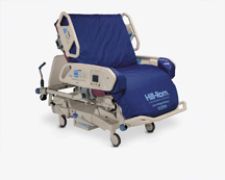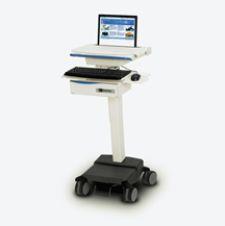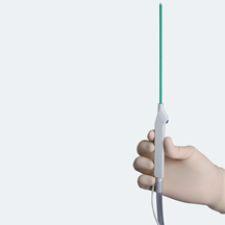
The TotalCare from Hill-Rom is an adjustable electric hospital air bed with features that allow the caregiver unrestrained access to patients and their needs.
Nurses are the primary healthcare providers in the U.S. today, taking on more and more responsibilities within the hospital and often working long, irregular shifts. A physically demanding profession, nursing is consistently listed as one of the top 10 occupations for work-related musculoskeletal disorders, according to the Bureau of Labor Statistics. By 2010, it’s estimated that 40 percent of nurses will be 50 years of age or older, potentially putting them at even greater risk for injury.
Recognizing the indisputable correlation between patient and nursing safety, hospitals are amping up initiatives to foster safer environments for staff and patients alike. A key contributor is the use of ergonomically designed products that address a variety of issues such as device maneuverability and patient handling.
A 27-year veteran of the nursing profession, Pat Stark, RN, ICU charge nurse at the Deborah Heart and Lung Center, Browns Mills, NJ, remembers the days when lifting the head of a patient’s bed required manually turning a crank at the foot of the bed. And she remembers the back and shoulder injuries that often resulted. Today, the center uses Hill-Rom’s motorized Total Care line of beds, and the nurses couldn’t be happier, says Stark.
“Our nurses absolutely adore these beds,” she said.
Features such as turn assist, head of bed alarm and trending, max inflate, and the rotation, percussion and vibration modules are some of the reasons why. These features eliminate awkward patient handling and movement, which benefits the nurses as well as the patients.
Stark said when the center made the change about nine years ago, they were determined to purchase a product that was the most beneficial for both the staff and the patient, and had a variety of surfaces that could be used throughout the hospital. She’s convinced safety and ergonomic features played a big part in the decision-making process.
“The max inflate feature makes it much easier to pull up patients and the chair egress position is fantastic for post-op patients, allowing them to ambulate easier and sooner,” Stark said. “We can also do chest PT without external devices. All we do is set the percussion, vibration and the rotation and raise the siderails — the bed does the rest.”
For sicker patients, such as open-heart patients who may have multiple drips or a balloon pump, the center relies on the TotalCare Sp02RT bed. Since these patients can’t increase their mobilization, the bed’s functions allow nurses to turn them and help increase their respiratory function, explains Stark. For extremely large patients — more than 400 pounds — the center has access to the TotalCare Bariatric Bed that features an extra-wide, 42-inch, three-layer surface for comfort and IntelliDrive power transport.
Nurses at Main Line Health in suburban Philadelphia recommend “try before you buy” when purchasing new devices. Several years ago the hospitals learned an expensive lesson when they purchased tablet PCs for their patient care technicians (PCTs) to use when performing vital signs documentation. The devices, which looked great at first glance, turned out to be very heavy and awkward to use, resulting in neck and shoulder pain. The tablets are now gathering dust while the PCTs collect their information by hand and transfer it into the hospital’s clinical documentation system from desktop computers.
As the result of their search for full-featured medication administration carts and computers on wheels that were smaller, lighter and easy to maneuver, Main Line Health went live four years ago with several of Infologix’s mobile computing workstations.
“In the past, we had injuries that resulted from pushing heavy carts. We also need to take into consideration that the nurses on the floor are getting older,” said Kristy Thompson, clinical IS educator for Main Line Health.
“When we evaluated the current market offerings, we liked the Infologix carts’ drawer size and wider base, which makes them easy to maneuver on floors,” said Nicole Talmadge-Kellet, PMP, IS application manager, Main Line Health. “However, some of the nurses tend to overfill the drawers, making the carts less easy to wield along the hospitals’ carpeted areas. The nurses also like that they can raise and lower the workstation and tilt the keyboard and monitor. There is a fairly large area between the monitor and keyboard where they can prepare meds or write notes, and there is a holder on the side of the cart for bar-code scanners.”
Recognizing that technology can change fairly rapidly, the nurses at Main Line Health have created a wish list for their next mobile computing purchase. The list includes increased maneuverability, smaller drawer size with a more individualized medication compartment and a hydraulic lift for adjusting the height of the workstation.
“This underscores the importance of real-life testing before you buy,” said Talmadge-Kellet. Just as important, is knowing exactly what you want and asking the right questions, she added. What MLH nurses really want, they say, is to test products backed by sophisticated design work and rigorous ergonomic research.
Better Design Leads to Better Outcomes
Ergonomics in healthcare goes way beyond comfort. Features that address not only ease of operation, but also optimized functionality, add to a device’s success. This is especially evident in the OR.
To help ease the hand fatigue many surgeons experience during electrosurgery procedures, MEGADYNE introduced a new line of disposable suction coagulators that boast a larger, ergonomic handle. Available in 8, 10 and 12 French sizes, the new line reportedly better enables the surgeon to correctly match the coagulator to the size of the patient’s anatomy and surgical procedure being performed. Available in both hand-switching and foot-controlled options, the coagulator is fully insulated to reduce the likelihood of injury to surrounding structures and tissue, and its integrated guard prevents user shocks.
Similarly, Medtronic’s Straightshot M4 Microdebrider is an ergonomically designed powered handpiece for sinus, nasal and laryngeal surgery. Its sculpted shape reportedly accommodates multiple hand positions and provides ergonomic comfort for small- and large-handed surgeons.
A 2006 Medical Device Excellence Award Silver Award winner, the Straightshot M4, said Medtronic, is designed to provide better, more comfortable access to sinus and airway anatomy, allowing surgeons to perform more precise, complete removal of obstructive or diseased tissue and help improve patient outcomes in chronic sinusitis and airway tumor surgery.




 November 04, 2021
November 04, 2021 









